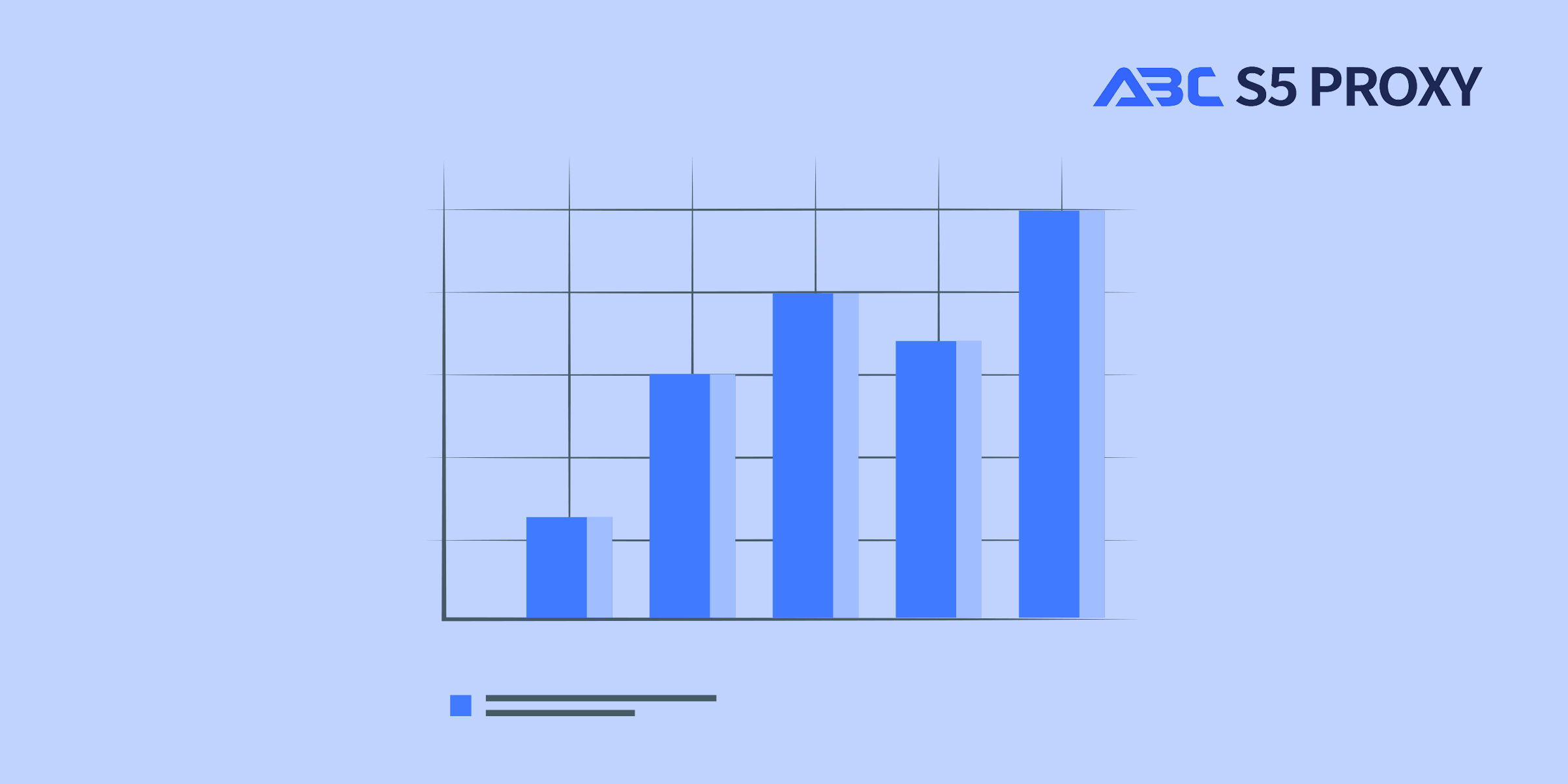Residential Proxies
Allowlisted 200M+ IPs from real ISP. Managed/obtained proxies via dashboard.

Proxies
Residential Proxies
Allowlisted 200M+ IPs from real ISP. Managed/obtained proxies via dashboard.
Residential (Socks5) Proxies
Over 200 million real IPs in 190+ locations,
Unlimited Residential Proxies
Use stable, fast, and furious 700K+ datacenter IPs worldwide.
Static Residential proxies
Long-lasting dedicated proxy, non-rotating residential proxy
Dedicated Datacenter Proxies
Use stable, fast, and furious 700K+ datacenter IPs worldwide.

Web Unblocker
View content as a real user with the help of ABC proxy's dynamic fingerprinting technology.
Proxies
API
Proxy list is generated through an API link and applied to compatible programs after whitelist IP authorization
User+Pass Auth
Create credential freely and use rotating proxies on any device or software without allowlisting IP
Proxy Manager
Manage all proxies using APM interface

Proxies
Residential Proxies
Allowlisted 200M+ IPs from real ISP. Managed/obtained proxies via dashboard.
Starts from
$0.77/ GB
Residential (Socks5) Proxies
Over 200 million real IPs in 190+ locations,
Starts from
$0.045/ IP
Unlimited Residential Proxies
Use stable, fast, and furious 700K+ datacenter IPs worldwide.
Starts from
$79/ Day
Rotating ISP Proxies
ABCProxy's Rotating ISP Proxies guarantee long session time.
Starts from
$0.77/ GB
Static Residential proxies
Long-lasting dedicated proxy, non-rotating residential proxy
Starts from
$5/MONTH
Dedicated Datacenter Proxies
Use stable, fast, and furious 700K+ datacenter IPs worldwide.
Starts from
$4.5/MONTH
Knowledge Base
English
繁體中文
Русский
Indonesia
Português
Español
بالعربية

MAP Monitoring and Minimum Advertised Price: A Comprehensive Guide
In the competitive landscape of e-commerce, maintaining brand integrity and ensuring fair competition among retailers are crucial for manufacturers. MAP monitoring and enforcing Minimum Advertised Price (MAP) policies have emerged as essential strategies to safeguard brand value and protect profit margins. In this article, we will delve into the significance of MAP monitoring, the benefits it offers, and effective ways to implement it.
MAP monitoring refers to the process of tracking and overseeing the prices at which a manufacturer's products are advertised or sold by retailers. The Minimum Advertised Price, established by the manufacturer, acts as the lowest price at which retailers can advertise the product for sale. While retailers are free to sell the product at any price they choose, violating the MAP policy by advertising below the set price can result in penalties or loss of privileges for the retailer.
1. **Brand Protection**: Maintaining a consistent pricing strategy ensures that the brand image remains intact and premium in the eyes of consumers. It prevents price wars and helps preserve the perceived value of the products.
2. **Fair Competition**: MAP monitoring promotes fair competition among retailers by creating a level playing field where all sellers have an equal opportunity to compete based on service and customer experience rather than engaging in price-cutting tactics.
3. **Profit Margin Preservation**: Enforcing MAP policies safeguards profit margins for both manufacturers and retailers. By preventing deep discounts that can erode margins, businesses can sustain profitability and invest in product development and marketing efforts.
1. **Enhanced Brand Loyalty**: Consistent pricing across various retail channels instills trust and loyalty among consumers. When customers perceive the brand as one that maintains value and fairness, they are more likely to make repeat purchases.
2. **Improved Relationships with Retail Partners**: MAP monitoring fosters stronger relationships with retailers as it demonstrates a commitment to supporting their business interests. By enforcing pricing policies, manufacturers show that they value their partnerships and are invested in mutual success.
3. **Legal Compliance**: Adhering to MAP regulations helps companies remain compliant with antitrust laws and avoid potential legal issues. By proactively monitoring and enforcing MAP policies, businesses can mitigate the risk of facing penalties or legal disputes.
1. **Utilize Technology**: Leveraging MAP monitoring software can streamline the process of tracking prices across multiple online platforms. These tools provide real-time data and alerts, making it easier to identify violators and take prompt action.
2. **Establish Clear Policies**: Communicate MAP policies clearly to all retailers and ensure they understand the consequences of non-compliance. Having transparent guidelines in place sets expectations and reduces the likelihood of misunderstandings.
3. **Regular Monitoring and Enforcement**: Consistent monitoring of pricing activities is key to detecting violations early. Implement a proactive approach to enforcement, which may involve warning notices, temporary suspensions, or termination of partnerships for repeated offenders.
MAP monitoring and enforcing Minimum Advertised Price policies are essential components of a successful brand strategy in the competitive e-commerce landscape. By prioritizing brand protection, fair competition, and profit margin preservation, businesses can cultivate a strong brand image, build customer loyalty, and foster mutually beneficial relationships with retail partners. Implementing effective MAP monitoring practices not only ensures compliance with regulations but also contributes to long-term business sustainability and growth.
Featured Posts
Popular Products
Residential Proxies
Allowlisted 200M+ IPs from real ISP. Managed/obtained proxies via dashboard.
Residential (Socks5) Proxies
Over 200 million real IPs in 190+ locations,
Unlimited Residential Proxies
Use stable, fast, and furious 700K+ datacenter IPs worldwide.
Rotating ISP Proxies
ABCProxy's Rotating ISP Proxies guarantee long session time.
Residential (Socks5) Proxies
Long-lasting dedicated proxy, non-rotating residential proxy
Dedicated Datacenter Proxies
Use stable, fast, and furious 700K+ datacenter IPs worldwide.
Web Unblocker
View content as a real user with the help of ABC proxy's dynamic fingerprinting technology.
Related articles

How does the ChatGPT RAG example improve information processing capabilities
Analyze the actual application scenarios of ChatGPT combined with Retrieval Augmented Generation (RAG) technology, explore its value in knowledge integration and data acquisition, and understand how abcproxy provides underlying support for the RAG system.

How does Best Socks5 Proxy ensure anonymous network needs
This article explores the core value of Socks5 proxy in anonymous networks and analyzes how abcproxy high anonymous proxy meets diverse security needs.

How to remove website access restrictions
This article analyzes the technical principles and mainstream solutions of website access restrictions, and explores the core role of proxy IP in bypassing regional blocking and anti-crawling mechanisms. abcproxy provides multiple types of proxy IP services to help you break through network restrictions efficiently.